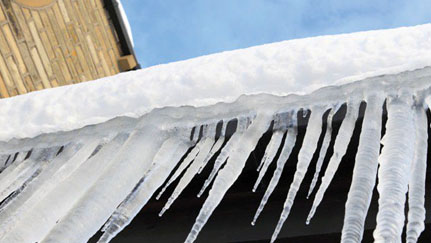Loading...
Prevent ice dam runoff from damaging your home

During the winter, ice dams can cause serious harm to your roof and home. Water damage is the most common preventable cause of loss facing homeowners today according to the Insurance Information Institute.1 It is important to protect yourself from the potential damage.
What are ice dams?
- Typically identified by large icicles along the roof line during the winter.
- An ice dam is a ridge of ice that forms along the edge of a roof that prevents melting snow from draining off the roof.
What problems are associated with ice dams?
- Roof leaks, which may cause interior water damage and may rot the structural components of a roof over time.
- Water intrusion will saturate insulation, reduce its effectiveness, and allow heat to escape.
- Heavy weight on gutters may cause significant damage to these components over time.
How can ice dams be prevented before a winter storm hits?
- Clean your gutters before winter begins. This reduces potential snow and ice buildup.
- Keep your attic space cold. Properly seal exhaust ducts from bathrooms/kitchens/dryers to prevent hot air from leaking into the attic. Professionally insulate and vent attics to allow cold air to circulate under the roof. This decreases the likelihood of the shingles getting warm.
- Keep your roof dry. Install a snow shield or an ice melting system on the roof. The system should be installed at least two feet up from the exterior wall. This will help prevent moisture back up from ice dams and help snow flow off the roof.
- If you cannot install a snow shield, try installing gutter heat tape. Although heat tape does not melt ice or snow, it does create channels in the snow for water to escape, which may prevent some of the ice dam effects.
What removal methods should be avoided?
- Nationwide Private Client Risk Solutions recommends hiring a professional roofer to remove the snow to better protect the surface of your roof.
- Avoid the use of a snow blower, shovel, or hammer. This may cause further damage to your roof and potentially make the problem worse.
If you have any questions, please contact your agent or Nationwide Private Client Risk Solutions professional. For more information on how you can help prevent losses, visit nationwide.com/solutionseries.
We offer this information to assist you in making decisions that can help mitigate your risk. While we cannot address every possible scenario or guarantee these tips will work for you, our goal is to support your efforts to protect yourself and your family.
[1] iii.org/fact-statistic/homeowners-and-renters-insurance